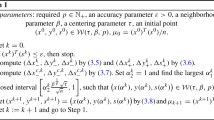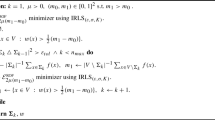Abstract
This article introduces a new point of view in the description and solution of neighborhood problems and, more specifically, to those arising in meshfree or simulations in computational mechanics. In particular, we focus on the solution of neighborhood computations when the problem involves two distinct sets of points whose positions change, and whose proximity needs to be repeatedly assessed. With this type of problems in mind, we reformulate the neighborhood concepts and propose a solution—implemented in an open source library—that possesses a simple interface, is suitable for parallelization, has very mild restrictions on the point data, depends only on the standard C++ library, and has a small memory impact. The presented algorithm employs hash tables to achieve constant time in point searches, integer lattices to define a grid of background cells, and classifies the two independent point sets. As a result, and in addition to the favorable features previously indicated, the method is very fast as compared with the available implementations for similar problem.

Similar content being viewed by others
References
Lucy LB (1977) A numerical approach to the testing of the fission hypothesis. Astron J 82:1013–1024
Gingold RA, Monaghan JJ (1977) Smoothed particle hydrodynamics - Theory and application to non-spherical stars. Mon Not R Astron Soc 181:375–389
Belytschko T, Gu L, Lu YY (1994) Fracture and crack growth by element-free Galerkin methods. Modelling Simul Mater Sci Eng 2:519
Sulsky D, Chen Z, Schreyer HL (1994) A particle method for history-dependent materials. Comput Methods Appl Mech Eng 118(1–2):179–196
Tuckerman M (2010) Statistical mechanics: theory and molecular simulation. OUP, Oxford
Li S, Liu WK (2004) Meshfree particle methods. Springer, Berlin Heidelberg
Belytschko T, Rabczuk T, Huerta A, Fernández-Méndez S (2004) Meshfree methods. Encycl. Comput Mech 1:10
Mattson W, Rice BM (1999) Near-neighbor calculations using a modified cell-linked list method. Comput Phys Commun 119:1351148
Yao Z, Wanga J-S, Liu G-R, Cheng M (2004) Improved neighbor list algorithm in molecular simulations using cell decomposition and data sorting method. Comput Phys Commun 161(1–2):27–35. doi:10.1016/j.cpc.2004.04.004
Mason DR (2005) Faster neighbour list generation using a novel lattice vector representation. Comput Phys Commun 170(1):31–41
Sutmann G, Stegailov V (2006) Optimization of neighbor list techniques in liquid matter simulations. J Mol Liq 125(2–3):197–203
Awile O, Büyükkeçeci F, Reboux S, Sbalzarini IF (2012) Fast neighbor lists for adaptive-resolution particle simulations. Comput Phys Commun 183(5):1073–1081
Allen MP, Tildesley DJ (1987) Computer simulation of liquids. Clarendon Press, Oxford
The CGAL Project (2015) CGAL User and Reference Manual, 4.6 edn. (CGAL Editorial Board). http://doc.cgal.org/4.6/Manual/packages.html. Accessed 10 June 2016
Mount DM (2010) ANN Programming Manual, version 1.1 edn. (http://www.cs.umd.edu/). http://www.cs.umd.edu/~mount/ANN/. Accessed 10 June 2016
Arya S, Mount DM, Netanyahu NS, Silverman R, Wu AY (1998) An optimal algorithm for approximate nearest neighbor searching fixed dimensions. J ACM 45(6):891–923. doi:10.1145/293347.293348
Andoni A, Indyk P (2008) Near-optimal hashing algorithms for approximate nearest neighbor in high dimensions. Commun ACM 51(1):117–122. doi:10.1145/1327452.1327494
Shilane P, Min P, Kazhdan M, Funkhouser T (2004) The Princeton shape benchmark. Shape Modeling International, Genova
Alns MS, Blechta J, Hake J, Johansson A, Kehlet B, Logg A, Richardson C, Ring J, Rognes ME, Wells GN (2015) The FEniCS project version 1.5. Arch Numer Softw Sl 3:100
Acknowledgments
Financial support for I.R. has been provided by Grant DPI2015-67667-C3-1-R from the Spanish Ministry of Economy and Competitiveness.
Author information
Authors and Affiliations
Corresponding author
Rights and permissions
About this article
Cite this article
Tapia-Fernández, S., Romero, I. & García-Beltrán, A. A new approach for the solution of the neighborhood problem in meshfree methods. Engineering with Computers 33, 239–247 (2017). https://doi.org/10.1007/s00366-016-0468-8
Received:
Accepted:
Published:
Issue Date:
DOI: https://doi.org/10.1007/s00366-016-0468-8




